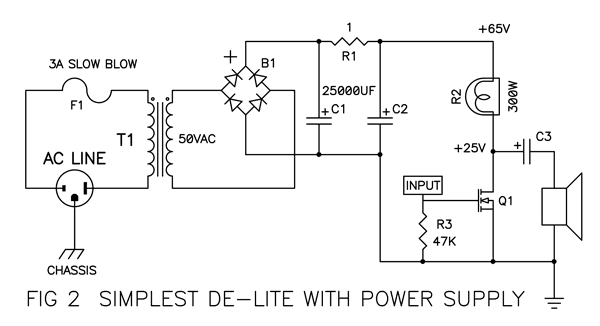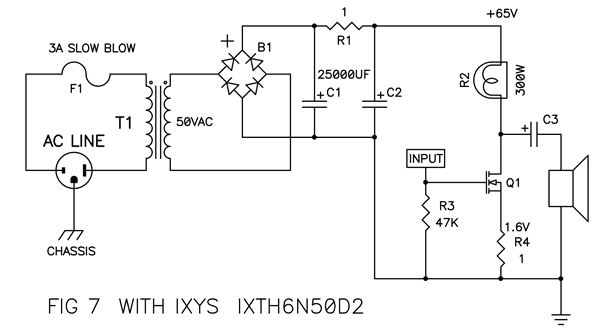Building an amp
Posted: Fri Jun 25, 2010 12:53 am
Hi all,
Some of you have asked for a simple description of what's involved in building an amplifier - with the finger pointed towards me as the one to do some explaining. So I've decided to take up the challenge, and the timing is particularly good as I've just completed a new amp in the past few days. I don't have pictures yet.... but I should get some going in a day or so.
So the first step is to sit down and decide on what you need in this amplifier. In my case, I needed something (well, I didn't actually need another amplifier, but hey, I didn't let that stop me!) with really high quality sound, great dynamics and clear clean tone with a touch of warmth not sterility. I use horns in my main system, so I didn't need much power (couple of watts is fine for me) and nor did I need much gain. The amp I will describe here will of course not suit many people - but it describes how I built it, and may provide some insight.
So to be completely honest, that's not quite how I came to decide on this amp, but still, these are the features of the amp I built. So, in my case what actually happened is that I had read about a new, very unusual amp that Nelson Pass (he of Pass Labs and First Watt) had designed and demonstrated at a DIY audio event in San Francisco. He also uses horns, and had tried out and experimented a bit with the amp and was happy with the result - a good start for me. Since then, the amp has been described as having a SET type sound, but a very good SET sound...... exactly what I would like.
The amp in question has now become known as the DeLite - and there are a few variations on the theme. One of the nice things about this amp is that the parts count is miniscule.... one of the bad things is that the mosfet used in it is unusual, and while available, is really only designed for industry and most sellers have a minimum buy of 50 or 100 pieces. I bought mine in a group buy....
So the first thing I suppose is to direct you towards the article Nelson wrote about the amp - you should really read this, as it helps a lot with understanding the various bits.
http://www.diyaudio.com/forums/diyaudio ... ifier.html
There is also a longish build thread on diyaudio about this amp - it details how others have fared building it, common pitfalls and of course serves as a place to ask questions.
http://www.diyaudio.com/forums/pass-lab ... p-baf.html
I should state straight up that I am no genius with electronics - I can build, put things in a case, solder well etc etc. but I am really a kits man, not the original inventor.

this is an example of the bare circuit (power supply not included)

Mr. Pass himself with the amp:

The amp at work:

So is anyone interested? Should I stay going and describe my progress?
Fran
Some of you have asked for a simple description of what's involved in building an amplifier - with the finger pointed towards me as the one to do some explaining. So I've decided to take up the challenge, and the timing is particularly good as I've just completed a new amp in the past few days. I don't have pictures yet.... but I should get some going in a day or so.
So the first step is to sit down and decide on what you need in this amplifier. In my case, I needed something (well, I didn't actually need another amplifier, but hey, I didn't let that stop me!) with really high quality sound, great dynamics and clear clean tone with a touch of warmth not sterility. I use horns in my main system, so I didn't need much power (couple of watts is fine for me) and nor did I need much gain. The amp I will describe here will of course not suit many people - but it describes how I built it, and may provide some insight.
So to be completely honest, that's not quite how I came to decide on this amp, but still, these are the features of the amp I built. So, in my case what actually happened is that I had read about a new, very unusual amp that Nelson Pass (he of Pass Labs and First Watt) had designed and demonstrated at a DIY audio event in San Francisco. He also uses horns, and had tried out and experimented a bit with the amp and was happy with the result - a good start for me. Since then, the amp has been described as having a SET type sound, but a very good SET sound...... exactly what I would like.
The amp in question has now become known as the DeLite - and there are a few variations on the theme. One of the nice things about this amp is that the parts count is miniscule.... one of the bad things is that the mosfet used in it is unusual, and while available, is really only designed for industry and most sellers have a minimum buy of 50 or 100 pieces. I bought mine in a group buy....
So the first thing I suppose is to direct you towards the article Nelson wrote about the amp - you should really read this, as it helps a lot with understanding the various bits.
http://www.diyaudio.com/forums/diyaudio ... ifier.html
There is also a longish build thread on diyaudio about this amp - it details how others have fared building it, common pitfalls and of course serves as a place to ask questions.
http://www.diyaudio.com/forums/pass-lab ... p-baf.html
I should state straight up that I am no genius with electronics - I can build, put things in a case, solder well etc etc. but I am really a kits man, not the original inventor.
example of how one member put it together:Correct on all counts. I think we're going to have some
DIY fun with this one, as it sounds far better than it has
any right to. - Nelson Pass

this is an example of the bare circuit (power supply not included)

Mr. Pass himself with the amp:

The amp at work:

So is anyone interested? Should I stay going and describe my progress?
Fran

